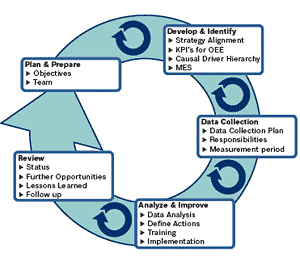Evaluating overall equipment effectiveness (OEE) is an established method for packaging line improvement with the objective of minimizing production costs through the optimum use of resources. Roland Pichler, OEE consultant at Bosch Packaging Technology, was on hand with Food Engineering to answer questions on how OEE consulting services work and how they benefit processors.

|
| Fig. 1.: The calculation of OEE consists of three categories: availability, performance and quality. Source: Bosch. |
FE: In production, every minute counts. For that reason, strategies for increasing efficiency have high priority. What role does OEE play in doing this?
Pichler: The important thing with OEE consulting is making the process transparent and measurable, and by using OEE as a key performance indicator, we can achieve [optimum efficiency].OEE as a metric is used to identify line efficiency at the start of the process and must be regularly checked to determine the progress toward reaching the objective.
Any loss in production is expensive for processors.Therefore, it is essential to know the exact causes of performance losses to be able to achieve maximum efficiency of the line equipment.OEE states the ratio of the actual to the theoretical output while considering the most common reasons for productivity losses.
The calculation of OEE consists of three categories:availability, performance and quality (Fig. 1).These factors are expressed in percentages as comparative values, which can be used to verify any implemented improvements.
FE: You have identified three key figures for calculating OEE: availability, performance and quality. What do these figures tell us about line equipment?
Pichler: Availability refers to machinery and workers that enable production according to a schedule. A machine only adds value when it is working. Regardless of whether downtime is caused by humans or machines, it costs the processor money. The availability score is calculated by comparing planned with actual machine production times or, in other words, by calculating the duration of unplanned machine downtime.
The performance figure calculates the waste of resources that arises when machines are not running at optimal speed. To determine the performance of the equipment, the actual machine run time is compared with the run time that is theoretically necessary to achieve the produced quantity. This means that items such as time losses arising when equipment is started up after downtime are also considered.
Quality is the third factor for the OEE calculation. It is used to determine how many products do not meet the required quality standards and are, therefore, rejected. For the processor, poor quality scores mean there is too much rejected material or post-processing required, consuming additional time and resources.
The three indicators are determined and evaluated during an OEE audit, which requires approximately four weeks. At the end of this phase, a report is created to summarize the results and provide detailed insights into overall line efficiency. Based on this report, the OEE consultant can give recommendations for line improvement. If a processor does not have the necessary tools in place to measure the three indicators, such as manufacturing execution systems (MES), external measuring devices can be used.
FE: How exactly does your company’s consulting work? Is a particular process applied?

|
| Fig. 2: Based on Six Sigma methods, Bosch’s OEE consulting service consists of five basic steps: plan and prepare, develop and identify, data collection, analyze and improve, and review. Source: Bosch. |
Pichler: Bosch’s OEE consulting service is based on a structured process that can be divided into five steps (Fig. 2). An improvement project requires planning and preparation, development and identification, data collection, analysis and improvement, and review phases.
These five steps, which are also known as the DMAIC (an acronym for define, measure, analyze, improve, control) or Six Sigma methods, form the core elements of our OEE consulting service.
We analyze client-specific problems in the plan-and-preparation phase as an entry into the project and convert these into a structured improvement project. In addition, we determine the project objective and project team in conjunction with the processor. Ideally, the project team should combine the processor’s product and process expertise with the OEE consultant’s method and machinery expertise. The project plan is created in this phase, with milestones to be issued by management.
In the development phase, each individual machine is rated based on the OEE audit and the available key indicators, including determination of possible causes for losses. This phase takes place in a workshop setting, attended by members of the combined teams. The possible loss causes are listed, assessed according to likelihood and processed according to the Pareto principle, which states 80 percent of the effects come from 20 percent of the causes.
The data collection phase monitors complex relationships between cause and effect using statistical analytical methods such as hypothesis testing before they are converted into appropriate approaches for measures and solutions. Complex relationships with several causes, such as temperature, material and product, are first verified using statistics before any measures or solutions are taken.
On the basis of these results, we compile a detailed action plan in the analysis and improvement phase. This reveals the causes of the inefficiencies and contains work packages that can be used to improve OEE. The suggested measures are discussed and evaluated with the project team and approved by the processor for implementation.
FE: How do you ensure your measures bring the results desired by the manufacturer over the long term?
Pichler: This is a very important point. Consistent monitoring of the improvement measures using the OEE key performance indicator is important for long-term results. This monitoring is implemented in Phase 5—the review process—and clearly shows whether the planned objectives have been reached and the solutions have contributed to improvement. A before-and-after comparison is performed, which highlights the improvements achieved.
However, as some measures for improvement only take effect later, such as training and further development, it is important to provide the processor with appropriate management tools, such as control charts that show progress or offer additional assistance in making a decision to enable action before inefficiencies set in.
Furthermore, OEE measurement and consulting create experience and empirical data that can be applied to other machines and future projects. In effect, OEE consulting begins a continuous improvement process.
FE: How has OEE consulting changed over the last few years and what does it have to offer the packaging industry in the future?
Pichler: OEE consulting was developed on the basis of the OEE key performance indicator devised in 1951 by the Japan Institute of Plant Maintenance. Today, OEE is an established and preferred calculation as it can be tailored to each processor’s individual needs and contains all of the important loss factors. In the future, OEE consulting will increase in importance in the development of machinery. Suggestions for improvements can be filtered into research and development and guarantee manufacturers are provided with machinery that meets the requirements of the market over the long term.
 About Roland Pichler
About Roland Pichler
Roland Pichler, manager OEE consulting, Bosch Packaging Services AG, has over 18 years of experience in the packaging industry and gained Six Sigma Master Black Belt Certification in 2002. He has more than 10 years of practice focusing specifically on quality and logistics.
For more information: Roland Pichler, Bosch Packaging Services, +41 58 674 6357, Roland.Pichler@bosch.com



